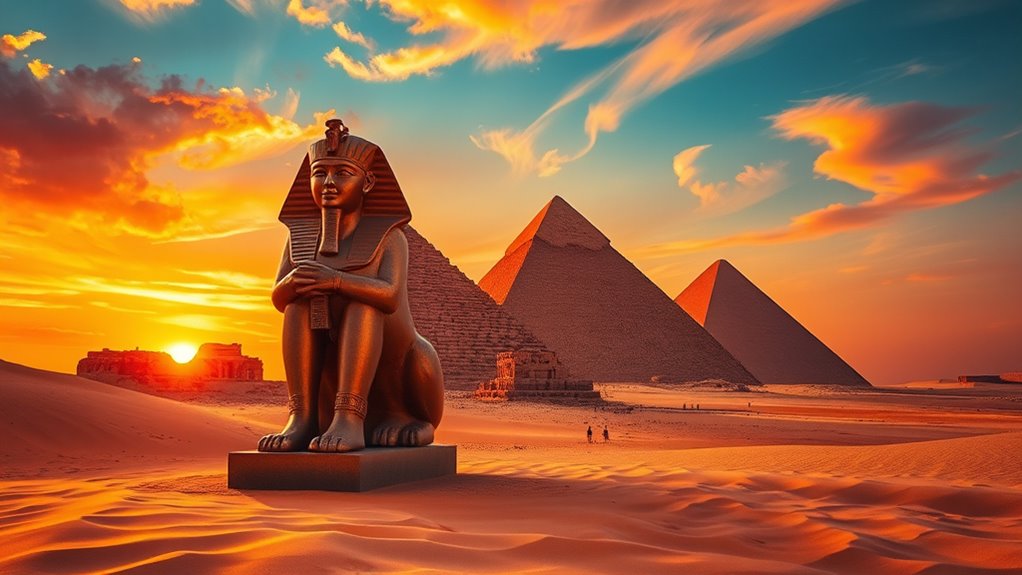Cairo’s pyramids and pharaohs showcase ancient grandeur and architectural brilliance that still captivates today. You’ll marvel at the Great Pyramid of Giza, a true engineering feat with its immense limestone blocks and precise alignment. The legacy of Pharaoh Khufu highlights a time of increased trade and cultural flourishing. As you explore the complex, you’ll encounter the iconic Sphinx, steeped in mystery and history. If you want to uncover more fascinating details, keep going.
Key Takeaways
- The Great Pyramid of Giza, built for Pharaoh Khufu, exemplifies ancient Egyptian architectural sophistication and ingenuity.
- Pharaoh Khufu’s reign saw significant trade and cultural developments, influencing Egypt’s identity and prosperity.
- The Giza Pyramid Complex, including pyramids for Khufu, Khafre, and Menkaure, showcases remarkable ancient craftsmanship and engineering.
- The Sphinx, attributed to Pharaoh Khafre, remains an iconic symbol of ancient Egypt, shrouded in mystery and intrigue.
- Pyramids continue to inspire modern architecture and serve as vital tourist attractions, enhancing Cairo’s economy and cultural significance.
The Great Pyramid of Giza: An Architectural Wonder
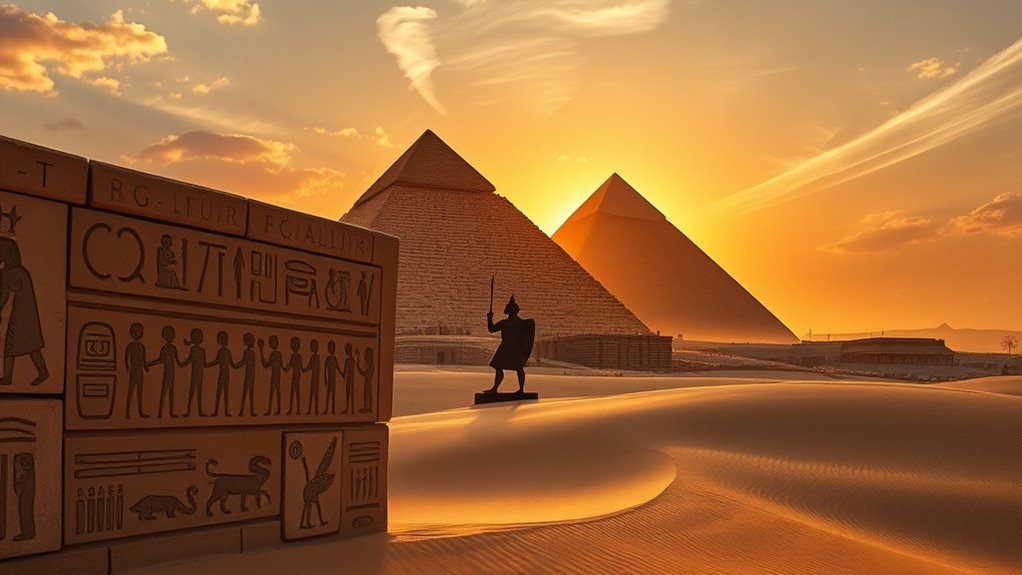
The Great Pyramid of Giza stands as a testament to the ingenuity of Ancient Egyptian architects and engineers.
Constructed around 2550 BC, this monumental structure consists of approximately 2.3 million limestone blocks, quarried locally and transported via the Nile. Its precise design features a square base averaging 230 meters per side and sides rising at an angle of 51°52′, perfectly aligned with the cardinal directions.
The pyramid’s height originally reached 146.5 meters, but erosion has reduced it to 138 meters. Inside, the King’s Chamber showcases granite blocks weighing up to 80 tonnes and includes innovative stress-relieving compartments. This architectural wonder not only served as a royal tomb but also reflects the remarkable engineering skills of its time, evident in the advanced construction techniques employed by skilled laborers.
The Legacy of Pharaoh Khufu
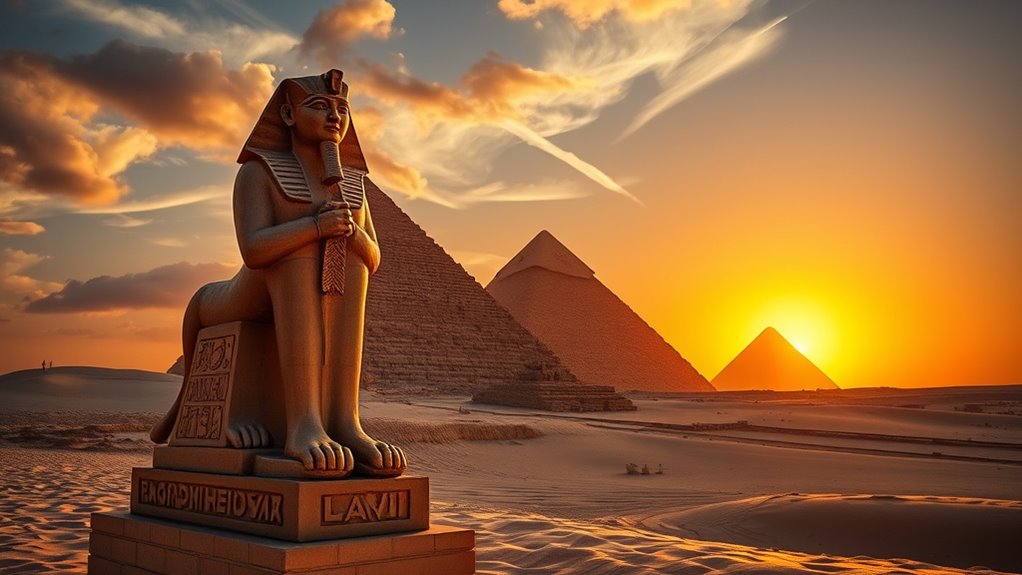
Khufu’s legacy extends far beyond the monumental Great Pyramid of Giza, symbolizing the height of Ancient Egyptian civilization during the Fourth Dynasty.
You’ll find that his reign, lasting between 23 and 50 years, marked a zenith in architecture and culture. As the son of Pharaoh Sneferu, Khufu continued a powerful lineage, influencing the political landscape through his notable children, including Khafre.
His leadership style sparked debate, yet it fostered increased trade and cultural patronage, laying the groundwork for future pharaohs. While historical records vary, often portraying him in contrasting lights, Khufu’s monumental achievements and support for the arts undeniably shaped Egypt’s cultural identity.
His enduring legacy continues to captivate both historians and the public today.
Exploring the Giza Pyramid Complex
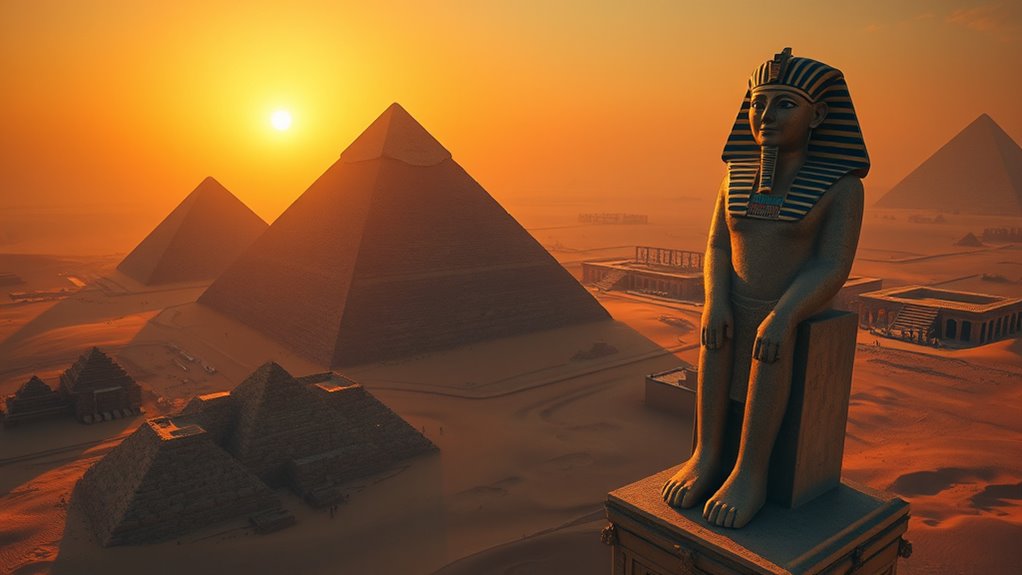
Exploring the Giza Pyramid Complex is like stepping back in time to witness the grandeur of Ancient Egypt.
You’ll encounter three magnificent pyramids, each built for a pharaoh: Khufu, Khafre, and Menkaure. As you wander, pay attention to the impressive limestone and granite blocks, showcasing ancient craftsmanship and engineering precision.
The Great Pyramid, originally 481 feet tall, stands as a testament to the 4th Dynasty’s architectural prowess. Don’t miss the smooth white limestone casing stones that once gleamed in the sun.
While some inner chambers are restricted, you can still explore surrounding temples and appreciate the pyramids’ spiritual significance as tombs designed for the pharaoh’s afterlife journey.
Explore the surrounding temples and discover the pyramids’ profound spiritual significance as sacred tombs for the pharaohs’ eternal journeys.
This UNESCO World Heritage site offers invaluable insights into ancient Egyptian culture.
The Mysteries of the Sphinx
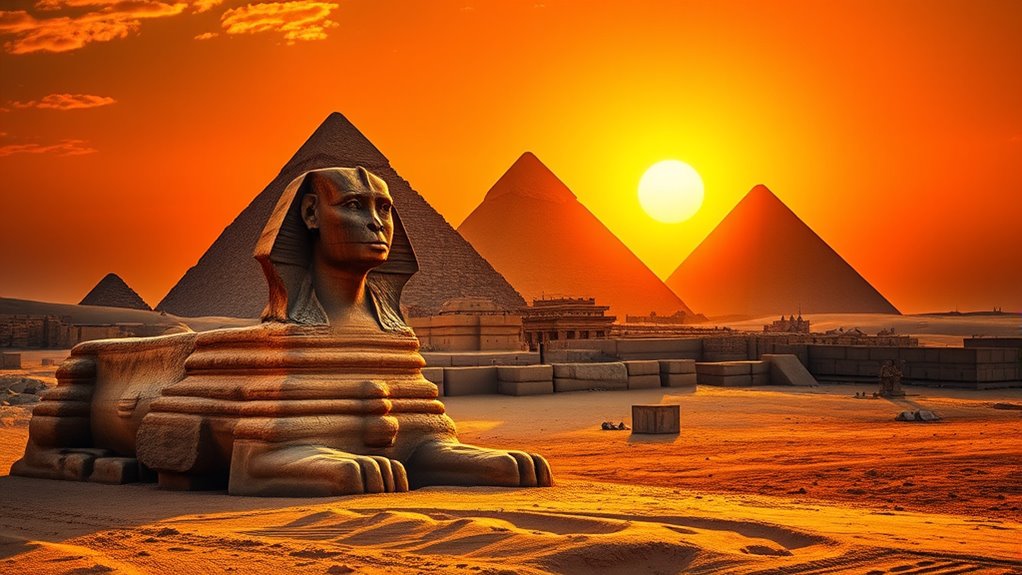
Have you ever wondered about the secrets hidden within the Great Sphinx of Giza? This colossal monument, believed to have been built around 2500 BC, is attributed to Pharaoh Khafre.
Carved from a single limestone block, it showcases incredible ancient engineering and craftsmanship. Unique erosion patterns spark debates about its age, with some theories suggesting it predates Egyptian civilization.
Visitors often speculate about lost chambers or its potential astrological alignments, yet no evidence confirms these ideas. As you stand before this majestic figure, consider its symbolic significance—representing not just Khafre or a deity like Horus, but the enduring mystery that captivates countless visitors.
The Sphinx remains a powerful emblem of ancient Egyptian culture and ingenuity.
The Evolution of Egyptian Pyramid Design

As ancient Egypt evolved, so did the design of its iconic pyramids, reflecting advancements in engineering and architectural ambition. Early structures like the mastabas laid the groundwork for pyramid concepts.
Pharaoh Djoser’s Step Pyramid at Saqqara marked a significant innovation, showcasing Imhotep’s design brilliance with its six-tiered layers. This prototype influenced later forms, especially during Sneferu’s reign, where true pyramids emerged.
Pharaoh Djoser’s Step Pyramid at Saqqara exemplified architectural innovation, paving the way for true pyramids under Sneferu’s reign.
The Meidum, Bent, and Red Pyramids demonstrated evolving techniques, despite challenges like structural collapses. The Giza Pyramids represented the pinnacle of this evolution, utilizing limestone and granite, crafted by a vast workforce.
However, by the Middle Kingdom, designs shifted to smaller, mudbrick structures, signaling the decline of the grand pyramid era while still inspiring future architectural endeavors.
Myths and Legends Surrounding the Pyramids

What stories lie hidden within the shadow of Egypt’s ancient pyramids?
You’ll find a tapestry of myths and legends that shape these monumental structures. Arab lore whispers that the Great Pyramid is Hermes’ tomb, safeguarding knowledge from the flood. King Surid’s dream inspired the pyramids, a vision to preserve wisdom as stars fell.
Yemeni Arabs claim these giants are tombs of their kings, echoing the Hyksos invasion. Caliph al-Mamun‘s legendary break-in around 820 AD adds intrigue.
Tales of hidden treasures, woven into The Thousand and One Nights, keep imaginations alive. Though Herodotus mixed fact with fiction, these narratives continue to captivate, inviting you to explore the mysteries and marvels that surround these ancient wonders.
The Cultural Impact of Pyramids on Modern Cairo
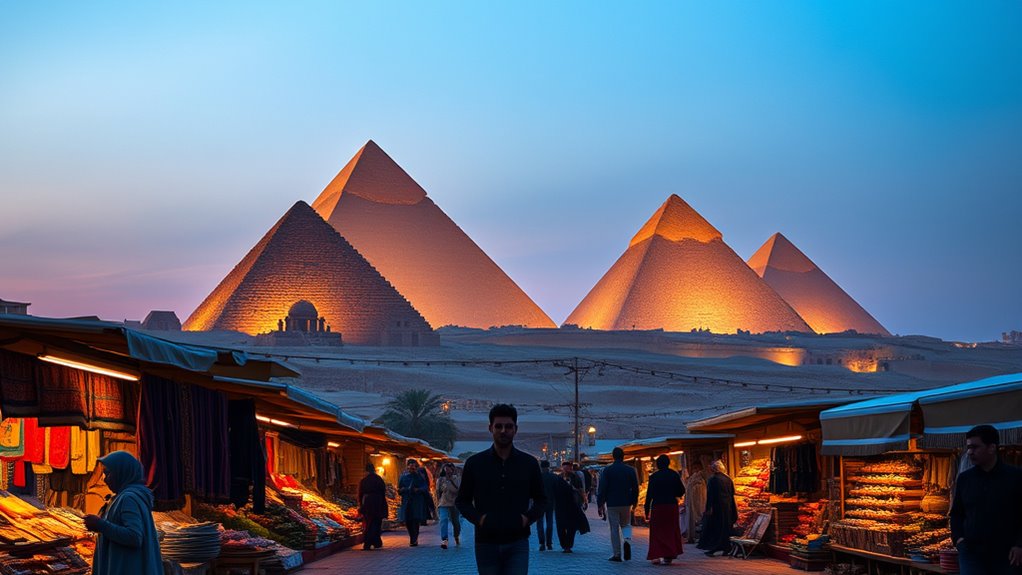
While the ancient pyramids stand as timeless symbols of Egypt’s rich heritage, their cultural impact on modern Cairo is both profound and far-reaching.
They inspire architectural designs globally, evident in structures like the Louvre Pyramid and the Luxor Hotel. These iconic shapes reflect the technological and artistic achievements of ancient Egypt, influencing contemporary building techniques.
As major tourist attractions, the pyramids significantly boost Egypt’s economy and support local businesses. They’re also educational resources, sparking interest in archaeology and history among students and scholars alike.
With new pyramids promoting cultural development in Cairo, the legacy of the original structures continues to shape urban planning and cultural identity, ensuring their relevance in today’s world.
Frequently Asked Questions
What Are the Best Times to Visit the Pyramids?
The best times to visit the pyramids are during the shoulder seasons of October to November and March to April, when the weather’s pleasant and crowds are thinner.
If you’re visiting in winter, early mornings right when the pyramids open at 8 am help you beat the heat and avoid the busiest times.
Avoid weekends, as they draw larger crowds.
Plan your visit wisely for a more enjoyable experience!
Are There Guided Tours Available for the Pyramid Complex?
Yes, there’re plenty of guided tours available for the Pyramid Complex.
You can choose from private or group options, which often cover the iconic Pyramids of Khufu, Khafre, and Menkaure, along with the Great Sphinx.
Most tours include entrance fees, transportation from your hotel, and insights from professional guides.
Depending on your preference, you can opt for half-day or full-day tours, some even featuring camel rides or visits to other archaeological sites.
What Is the Dress Code for Visiting the Pyramids?
You’d think visiting the Pyramids means donning a tuxedo, but it’s quite the opposite!
For a comfortable experience, wear light, loose clothing in breathable fabrics. Avoid dark colors and tight outfits to respect local customs.
Opt for comfortable shoes for uneven terrain, and don’t forget sun protection with a wide-brimmed hat.
While there’s no strict dress code, dressing modestly shows respect and enhances your experience at these magnificent historical sites.
How Can I Access the Pyramids From Downtown Cairo?
To access the pyramids from downtown Cairo, you’ve got several options.
Taxis offer a quick ride, taking about 14 to 30 minutes, especially if you use ride-hailing apps like Uber to save on costs.
Alternatively, you can take the metro to El-Giza station and switch to a bus or taxi for the rest of the journey.
If you’re feeling adventurous, walking is an option, but it’ll take several hours.
Are There Any Restrictions on Photography at the Pyramids?
When it comes to photography at the pyramids, you’ll want to tread carefully.
While you can snap away outside, inside the pyramids, restrictions apply. No tripods or DSLRs are allowed in certain areas, and video recording is off the table in places like the Great Pyramid’s inner tomb.
Always respect local customs and seek consent from individuals before photographing them.
Following these guidelines will keep your experience smooth as silk.
Conclusion
Visiting Cairo’s pyramids and pharaohs feels like stepping into a time machine. You can’t help but marvel at the ingenuity of the ancients, just like you’d admire a modern skyscraper today. The echoes of history linger, reminding you that these towering structures are more than just stone—they’re symbols of ambition, mystery, and legacy. As you leave, think about how the past shapes our future, much like how a selfie captures a moment in time.
